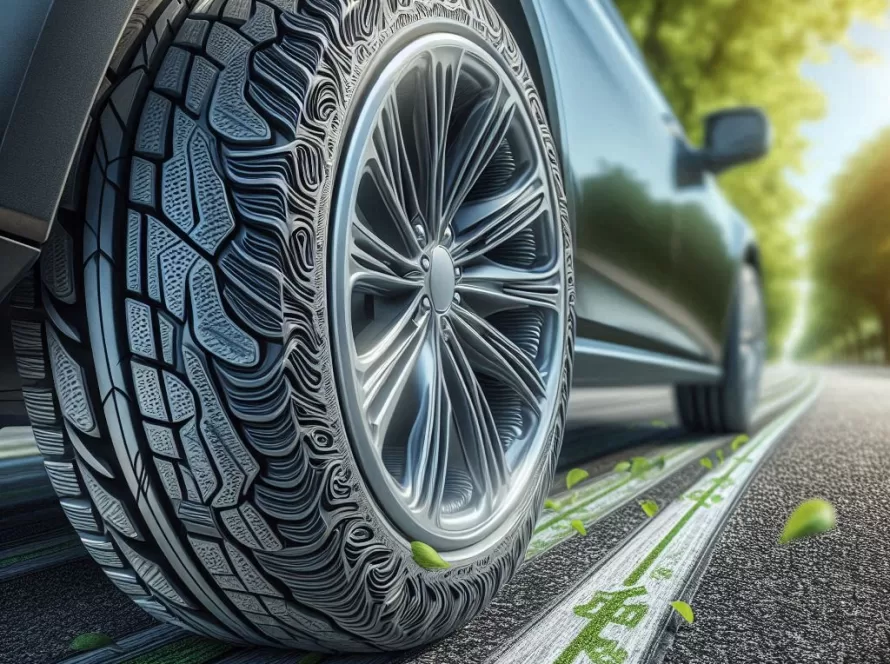
Table of Contents
Introduction
In the world of automotive technology, advancements are constantly being made to enhance the driving experience and ensure greater safety on the roads. One such innovation is the run-flat tire, a type of tire designed to resist the effects of deflation when punctured. This article delves into the pros and cons of run-flat tires, offering insights into their technical specifications, applications, and overall impact on the driving experience. But are they the right choice for you? Let’s find out.
Understanding Run-Flat Tires
What Are Run-Flat Tires?
Run-flat tires are designed to allow you to continue driving your vehicle even after a puncture has caused a loss of air pressure. This ability is achieved through reinforced sidewalls that can support the weight of the vehicle temporarily, usually allowing you to drive up to 50 miles at a reduced speed to reach a repair shop.
How Do Run-Flat Tires Work?
These tires rely on either a self-supporting or a support-ring system. The self-supporting system uses reinforced sidewalls to bear the vehicle’s weight when the tire loses air pressure. The support-ring system involves a hard rubber or plastic ring attached to the wheel, which takes over when the tire is deflated. Both systems are designed to keep the vehicle stable and allow for continued driving after a puncture.
The Pros of Run-Flat Tires
Enhanced Safety
One of the most significant advantages of run-flat tires is the increased safety they offer. With run-flat tires, drivers can avoid the dangerous situation of having to change a tire on the side of the road. This feature can be particularly beneficial in hazardous weather conditions or on busy highways.
Convenience
Run-flat tires provide the convenience of not having to replace a tire immediately after a puncture. This means you can drive to the nearest repair shop without having to worry about being stranded. The ability to continue driving with a flat tire can be a lifesaver in remote areas where assistance might not be readily available.
No Need for a Spare Tire
Since run-flat tires can temporarily function even after a puncture, they eliminate the need for a spare tire. This can save space and reduce weight in the vehicle, potentially improving fuel efficiency and freeing up cargo space.
Improved Handling
The rigid sidewalls of run-flat tires can lead to improved handling and stability, particularly during cornering and high-speed maneuvers. This can enhance the overall driving experience, providing a sportier feel and better performance on the road.
The Cons of Run-Flat Tires
Cost
Run-flat tires are generally more expensive than traditional tires. The higher price is due to the advanced technology and materials used in their construction. This initial cost can be a significant deterrent for budget-conscious consumers.
Ride Comfort
Many drivers report that run-flat tires offer a harsher ride compared to standard tires. The stiffer sidewalls, which are necessary for maintaining the tire’s shape when deflated, can result in less shock absorption and a bumpier driving experience.
Limited Availability
Not all tire shops stock run-flat tires, which can make finding replacements more challenging, especially in remote or rural areas. This limited availability can lead to longer wait times for tire replacement and inconvenience if you find yourself in need of a new tire while traveling.
Shorter Lifespan
Run-flat tires often have a shorter lifespan than conventional tires. The added stress on the sidewalls and the materials used can lead to quicker wear and tear. As a result, you may find yourself replacing run-flat tires more frequently, which can negate some of the cost benefits of not needing a spare tire.
Limited Repairability
In many cases, run-flat tires cannot be repaired after a puncture. This limitation is due to the potential for damage to the reinforced sidewalls, which may not be visible. As a result, a puncture that would be repairable in a standard tire might require a full replacement of a run-flat tire.
Technical Specifications of Run-Flat Tires
Design and Materials
Run-flat tires are constructed with robust materials that enhance their durability and performance. The sidewalls are typically reinforced with heat-resistant rubber compounds, which allow them to support the vehicle’s weight when deflated. This construction requires precision engineering to balance strength with flexibility.
Speed and Distance Limitations
While run-flat tires allow you to continue driving after a puncture, there are limitations to how far and how fast you can go. Most manufacturers recommend a maximum speed of 50 miles per hour and a maximum distance of 50 miles when driving on a deflated run-flat tire. Exceeding these limits can lead to further damage to the tire and potentially compromise your safety.
Applications of Run-Flat Tires
Passenger Vehicles
Run-flat tires are most commonly found on passenger vehicles, particularly those that prioritize safety and convenience. Luxury and sports car manufacturers often equip their vehicles with run-flat tires as a standard feature due to the enhanced handling and performance characteristics they offer.
Fleet Vehicles
Fleet vehicles, such as delivery vans and service trucks, can benefit from run-flat tires by minimizing downtime caused by flat tires. This can improve operational efficiency and reduce the need for immediate roadside assistance.
Emergency and Law Enforcement Vehicles
Emergency and law enforcement vehicles require reliable performance in critical situations. Run-flat tires ensure that these vehicles can continue to operate even after a tire puncture, which is essential for maintaining response times and ensuring public safety.

Latest Innovations in Run-Flat Tire Technology
Improved Materials
Recent advancements in tire technology have led to the development of new materials that enhance the performance and longevity of run-flat tires. These materials offer better heat resistance and durability, addressing some of the limitations associated with earlier run-flat tire models.
Adaptive Design
Innovations in adaptive design have allowed for run-flat tires that adjust to varying road conditions and driving styles. This adaptability improves ride comfort and handling, making run-flat tires a more appealing option for a broader range of drivers.
Integration with Smart Technology
Modern run-flat tires can now be integrated with smart technology, providing real-time data on tire pressure, temperature, and wear. This information can be transmitted to the driver’s smartphone or vehicle dashboard, offering greater control and insight into tire performance.
Challenges and Limitations of Run-Flat Tires
Ride Comfort and Noise
As previously mentioned, the stiffer sidewalls of run-flat tires can lead to a harsher ride. This issue can be exacerbated by increased road noise, which some drivers find undesirable. Manufacturers continue to work on improving the comfort and noise levels of run-flat tires to address these concerns.
Repairability Issues
The limited repairability of run-flat tires remains a challenge for many drivers. While technological advancements have improved some aspects of run-flat tires, the ability to repair them after a puncture remains a significant limitation.
Cost vs. Benefits
For many consumers, the higher cost of run-flat tires can outweigh the benefits they offer. While they provide safety and convenience, the additional expense and shorter lifespan can be a deterrent, especially for drivers who do not frequently encounter situations where a spare tire would be needed.
Comparative Analysis: Run-Flat Tires vs. Conventional Tires
Performance
While run-flat tires offer enhanced handling and safety features, conventional tires often provide a smoother ride and longer lifespan. Drivers who prioritize comfort and cost-effectiveness may prefer traditional tires, while those who value safety and convenience might opt for run-flats.
Cost
Run-flat tires are generally more expensive than conventional tires, both in terms of initial purchase price and replacement costs. The added cost is a consideration for drivers weighing the benefits of run-flat technology against their budget.
Availability
Conventional tires are widely available at most tire shops, whereas run-flat tires may be harder to find. This difference in availability can be a deciding factor for drivers who need quick and easy access to tire replacements.
Expert Insights on Run-Flat Tires
Automotive Engineers
Automotive engineers often highlight the safety advantages of run-flat tires, particularly in preventing accidents caused by sudden tire deflation. They emphasize the importance of choosing run-flat tires based on the specific needs and driving habits of the vehicle owner.
Tire Manufacturers
Tire manufacturers continue to invest in research and development to improve the performance and comfort of run-flat tires. They recommend consulting with a tire specialist to determine the best type of tire for your vehicle and driving conditions.
Professional Drivers
Professional drivers, such as those in the delivery or transportation industry, often appreciate the convenience and reduced downtime that run-flat tires provide. They note that the ability to continue driving after a puncture can be invaluable in maintaining schedules and meeting deadlines.
User Guides for Run-Flat Tires
Installation and Maintenance
Installing run-flat tires requires specialized equipment and knowledge. It is crucial to have them installed by a professional to ensure proper alignment and performance. Regular maintenance, including checking tire pressure and inspecting for damage, is essential for maximizing the lifespan and efficiency of run-flat tires.
Monitoring Tire Condition
Modern run-flat tires often come equipped with tire pressure monitoring systems (TPMS), which alert drivers to changes in tire pressure. Regularly monitoring the condition of your tires can help prevent potential issues and ensure optimal performance.
Driving Tips
When driving on run-flat tires, it is essential to adhere to the recommended speed and distance limitations after a puncture. Exceeding these limits can lead to further tire damage and compromise your safety. Additionally, being mindful of road conditions and avoiding potholes and debris can
Conclusion
Run-flat tires offer a unique combination of safety, convenience, and performance that appeals to many drivers. While they come with certain drawbacks, such as higher costs and a firmer ride, their ability to prevent roadside tire changes and provide peace of mind is a significant advantage. Ultimately, the decision to choose run-flat tires depends on individual preferences and driving needs. By weighing the pros and cons, considering expert insights, and assessing your driving habits, you can determine if run-flat tires are the right choice for you. Whether you’re a daily commuter, a frequent traveler, or someone who values safety and convenience, understanding the features and limitations of run-flat tires can help you make an informed decision that suits your lifestyle.
Frequently Asked Questions (FAQs)
1. Are run-flat tires compatible with all vehicles?
Not all vehicles are compatible with run-flat tires. Vehicles must have a tire pressure monitoring system (TPMS) to ensure safe use, as run-flat tires rely on monitoring to alert drivers to pressure changes. Additionally, some vehicles may require specific wheel sizes or suspension adjustments to accommodate run-flat tires.
2. Can I mix run-flat tires with regular tires on my vehicle?
Mixing run-flat tires with regular tires is generally not recommended. Doing so can lead to handling and stability issues due to differences in tire construction and performance characteristics. It’s best to use a complete set of run-flat tires to ensure consistent handling and safety.
3. How do I know if my vehicle has run-flat tires?
To determine if your vehicle has run-flat tires, check the sidewall of the tire for markings indicating run-flat technology. Common markings include “RFT,” “ZP” (Zero Pressure), or “SSR” (Self Supporting Run-flat). Your vehicle’s owner’s manual may also provide information about the type of tires equipped.
4. Can run-flat tires be repaired after a puncture?
In many cases, run-flat tires cannot be repaired after a puncture due to potential damage to the reinforced sidewalls. It’s essential to consult with a tire professional to assess the extent of the damage and determine whether repair is possible.
5. Do run-flat tires affect fuel efficiency?
Run-flat tires may impact fuel efficiency due to their additional weight and stiffer construction. However, the difference in fuel consumption is often minimal compared to the safety and convenience benefits they provide.
Read Article The Pros and Cons of Run-Flat Tires: Are They Right for You?



1 Comment
James Williams
Great overview of run-flat tires! Your discussion on the advantages and disadvantages is really insightful. I’m particularly interested in the balance between the added safety and convenience of run-flats versus their potentially higher cost and firmer ride. Could you elaborate a bit more on how they perform in various weather conditions and whether they affect handling or fuel efficiency? Also, any advice on whether they’re a good option for everyday driving versus long trips? Thanks for the thorough analysis—it’s helping me weigh my options more carefully!